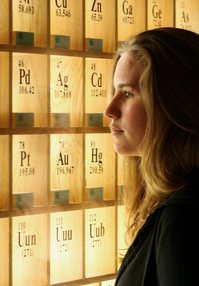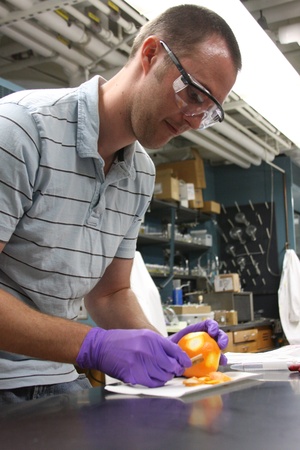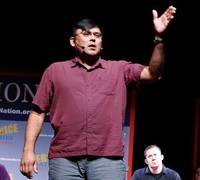Once dismissed as “hippie chem,” the rise of green chemistry at the UO has been a prime catalyst in a global movement toward environmentally conscious methods and results.
By Marc Dadigan
 Dana Garves was fascinated with chemistry the moment her 8th grade teacher unveiled the periodic table.
Dana Garves was fascinated with chemistry the moment her 8th grade teacher unveiled the periodic table.
As he described the first 20 elements, she was captivated by the image of electrons hurtling through space around the nucleus, like a miniature galaxy of celestial bodies orbiting and pulsating in everything she touched, even the very desk she was sitting in. “Just to think that this was the building block of all matter, it was fascinating,” said Garves, now a UO senior. “I was hooked, but I didn’t think I’d ever go into it as a career.”
Garves (right) was the sort of teen who would rescue unnecessarily discarded aluminum cans and plastic bottles from her friends’ homes for recycling. She was raised with a mind steeped in green, a color that seemed to clash with her chemistry interests.
“I had issues with toxicity in chemistry,” she said. “But in high school labs no one taught us about that. I’d be wondering why we couldn’t use the chemicals we read about. I’d think: If they’re so dangerous why don’t we use something else?”
Nevertheless, she enrolled at the University of Oregon as a chemistry major, thinking she would probably switch eventually. On the first day of her introductory chemistry class, however, she heard two words that changed everything: “Green chemistry.”
“I had no idea this place was a green chem hub, so I did some online research that day, and I was like, ‘This is right up my alley!’” she said. “Now I’m so passionate about it.”
It can’t be said that green chemistry was born at the UO, but it certainly took a major leap forward here when UO chemists Ken Doxsee and Jim Hutchison wrote the first green curriculum from scratch. Over the past decade, green chemists at the UO have been instrumental in its spread to universities and private industries across the country.
Chemistry is about the manipulation of matter, finding substances that will produce a reaction to create the intended final product. In this context, the principles of green chemistry seem relatively simple—use smaller amounts of starting materials, seek reactions that create as little waste as possible and be constantly conscious of how a new substance might affect the environment once in use.
But green chemistry represents a tectonic shift in the philosophy and thinking of an entire science.
A Cure for Tunnel Vision
“Through the decades, we became so amazed by what chemistry could produce that we never really talked about what happened when we used these chemicals or about the waste from producing them,” said Doxsee, a UO chemistry professor. “Green chemistry says we have to think about these things.”
Since Rachel Carson’s seminal book Silent Spring first brought to light the harmful health and ecological side effects of DDT, chemists have often been the villains in modern environmental fables. From PCBs to BPA, there has been a growing list of modern chemicals proven to be highly toxic well after they have been thoroughly dispersed as products in the economy.
Chemists had tunnel vision. It was all about producing the final product, and concerns about toxicity or efficiency were largely absent, especially in the classroom.
“It used to be you could just bury it in the yard, dump it in a river or pump it through a smokestack into the atmosphere and it wasn’t a big deal,” Doxsee said. “We thought the Earth was big, and it would take a lot to have an effect. But we discovered the world wasn’t as big as we thought it was.”
Scientifically, the approach of green chemistry strives to reduce or eliminate these hazards across the full life cycle of a chemical, from its creation to its degradation back into the environment.
“If I make the product recyclable or biodegradable, I might have made an improvement, but what’s the energy cost?” said Hutchison, who holds the UO’s first endowed chair in green chemistry. “Did I just increase my carbon footprint fivefold in the process of producing the product? Or if I decreased the carbon, did I just make (the product) more toxic? We’re looking at how every change impacts the whole cycle.”
Safer Solvents
Doctoral student Doug Young (below) cut little patches of orange peel with a razor blade and dropped them into a test tube along with some smoky crystals of dry ice, or frozen carbon dioxide.
 He sealed the tube tightly and placed it into a graduated cylinder full of water, peering at it through his goggles like a painter inspecting his last few brushstrokes. After a few moments, the bottom of the tube started to roil and bubble around the peels. “This is going to be a nice one,” he said.
He sealed the tube tightly and placed it into a graduated cylinder full of water, peering at it through his goggles like a painter inspecting his last few brushstrokes. After a few moments, the bottom of the tube started to roil and bubble around the peels. “This is going to be a nice one,” he said.
He was conducting a trademark experiment of the green chemistry curriculum. As the pressure built in the cylinder, the dry ice turned into liquid carbon dioxide, which in turn interacted with the orange peel. This extracts limonene, a substance that gives oranges their citrusy scent and is often used in household cleaners.
Young tapped the test tube and pointed to a small milky drop at the bottom, the limonene. “It used to be you had to use toxic solvent to do this, but by switching to carbon dioxide, you can just pour this down the sink when you’re done.”
While solvents are still needed to catalyze reactions, many green chemists are moving away from using more hazardous solvents, which typically leave behind messy liquid wastes.
Prior to the late 1990s, experiments like the CO2 extraction of limonene didn’t exist at the UO. Chemistry professors, at the UO and around the nation, were teaching experiments that hadn’t been altered or updated for decades.
But then, driven by practical concerns rather than idealism, individual faculty members started making changes in the ways they taught chemistry classes and labs—small incremental changes as well as bolder leaps forward that eventually transformed the way chemistry is taught at the UO. But only eventually.
“It was not a glamorous start,” Hutchison admitted.
Waste Not Wanted
Deborah Exton was one of the first UO faculty members to take initial steps in a green direction.
Soon after she was hired in 1993, she was assigned to teach the general chemistry laboratory course, and began to take a careful look at the experiments in the curriculum. “With over 500 students in the lab class, I was concerned about both the quantity and the category of waste that was being produced by just this one class,” she said.
She was also concerned about chemical exposure for both the students and staff. “Staff exposure is a particular concern because they are working with the chemicals 40 hours per week, unlike the students who are only in the lab for three hours per week,” she explained.
Over time, she has set about revamping the general chemistry curriculum, assessing each experiment for alternatives: Could more benign chemicals be used and still demonstrate the same principles? If not, was there a safer, less toxic experiment that could take its place?
One spectrometry lab assignment typically produced 80 gallons of aqueous copper sulfate—waste requiring hazardous waste disposal—but Exton changed the procedure so all of the experiment’s products could be poured down the drain with no harm to students or staff members.
Instead of copper sulfate, “we used FD&C Red Dye #40 as our colored solution and students had to determine how many glasses of Kool-Aid they would have to drink to get a lethal dose of this food additive,” she said. (Answer: Lots!)
Unaware of Exton’s efforts, the faculty members teaching organic chemistry began devising their own green solutions for a rather prosaic problem: lack of lab space. The organic chemistry labs had to accommodate several hundred students, and those students were required to perform many experiments under fume hoods so they wouldn’t be exposed to toxic fumes. Yet there were only enough hoods for about 18 students, meaning there had to be many lab sections—the organic professor had to oversee 11 or 12 three-hour labs a week.
This became Hutchison’s problem to solve, and he was still brainstorming when he walked into the department’s library and saw a brand new copy of a book titled Green Chemistry: Designing Chemistry for the Environment. Immediately the light bulb went on.
“Some of those solvents we were using in the lab were basically like the old paint stripper that would get you lightheaded,” Hutchison said. “When I saw the book, it just clicked. With green chemistry, we could make the experiments safer, make the hoods unnecessary and increase the capacity of the labs.”
His colleague Doxsee had long been developing experiments and altering them to reduce his students’ exposure to toxic substances. Though he didn’t think of it this way, he was already upholding certain green principles. Once he heard about Hutchison’s project, he signed on.
Hippie Chem
The two had one term, 10 weeks, to devise a curriculum completely counter to all that came before it. They delved into chemistry textbooks and the appropriate literature, looking for the right experiments, but found almost nothing. Some experiments fit the green criteria but didn’t necessarily illustrate the appropriate principles, and vice versa.
With the help of grad students, Doxsee and Hutchison hit the laboratory and devised the curriculum by adapting existing experiments or creating some from whole cloth.
The first term the curriculum was unveiled, Hutchison arrived at the organic lecture and asked for volunteers. About 20 students agreed to be green chemistry guinea pigs, but many students harbored doubts. Some thought it wasn’t real chemistry. “Hippie chem” was a term bandied about, which probably wasn’t helped by one student showing up to the first green lab in bare feet. “I had to tell him to put some shoes on before he could enter the lab.” Hutchison said.
Eventually all the labs were converted to green chemistry, and most doubting Thomases were also converted when they saw the science was basically the same.
Hutchison and Doxsee later wrote the first green chemistry textbook, as they started to see how this wasn’t simply a practical space-saving solution but an important step in their field’s evolution. This in turn evolved into a commitment to train their scientific peers.
“We realized the next step was to teach other people how to do this,” Doxsee said. “Otherwise if they didn’t understand the book they’d just dismiss it.”
Green Means Cheap
Green chemistry is unlike many other environmental movements because it’s extremely attractive to the very industry that in many instances gave chemistry a bad name in the first place.
The interest stems from the simple fact that green chemistry also often means cheap chemistry. Take for instance, ibuprofen, one of the most common industrial drugs. For every bottle of finished product almost three bottles worth of waste was produced before green chemists streamlined the production process. Now it’s one bottle of waste for every bottle produced.
“The pharmaceutical companies are using green chemistry to redesign production methods for a lot of their drugs because many of them create so much waste, and it costs money to get rid of that waste,” says Julie Haack, assistant department head and senior instructor of chemistry. “For us, that’s the low-hanging fruit.”
Many say the real stimulus for green chemistry began with the passage of the 1990 Pollution Prevention Act, which placed the financial burden on companies for cleaning up chemical waste, thus providing an incentive to avoid producing waste in the first place. But green chemistry is a proactive approach that inspires innovation rather than imposing new regulation, Hutchison says, and the fact that industry is embracing green chemistry is a sign they can also do the right thing.
In fact, industry has been a highly proactive force in getting on board with green. “Industry has been faster than academia,” Haack said.
The UO, especially behind the efforts of Haack, is working hard to increase the spread to academia, a realm that’s hardly known for its quick acceptance of change. Every summer, the chemistry department holds a weeklong workshop where it trains professors from around the world in the principles and practice of green chemistry. About 180 faculty members have been trained, and they in turn have influenced nearly 30,000 students across the country. Haack says surveys show they’re also influencing their colleagues.
But the real impetus is the wave of graduate students who are seeking PhDs at major universities where they’re asking for green chemistry courses. “The universities have to change to recruit these top students,” Haack said.
Once professors jump the mental hurdle of changing their approach, Haack said, green chemistry is “sticky” because it engenders a new and more satisfying relationship between teachers and students.
“Chemistry was a profession where you tended to work more in isolation, but cooperation is a big part of the green ethos,” she said.
Crowd-Sourced Chemistry
Haack is a catalyst for this nationwide cooperation through the creation of the GEMs (Greener Education Materials) database. It’s a “living” online database through which chemistry educators can share, develop and edit various experiments and curricula. It’s a sort of open-source green chemistry curriculum, which Haack hopes will not only stimulate the creation of new experiments but also incorporate input and insight from those outside the usual academic circles.
“We wanted a resource where people could cruise around and find out what’s available,” Haack said. “If they wanted to teach something on bonding, for example, on GEMs they could find the green experiment for that lesson.”
GEMS also allows different people to help develop the materials. Instead of one person creating a lesson, sometimes as many as 10 people will be involved, which helps green chemistry expertise mushroom all the more quickly.
Haack is also using social networking to spur collaboration across disciplines via the Green Product Design Network (GPDN), an effort to lay pathways for viable green chemistry products to enter the economy.
The GPDN includes UO professors and students as well as external partners who specialize in product design, business, public relations, marketing and other disciplines that can help shape the products even as they’re being conceptualized. By incorporating more disciplines in the beginning, it will help make green products more economically viable.
While some might say green chemistry is too focused on industry, Hutchison says there is so much we need to discover in order for green chemistry to flourish as a discipline that the participation of industry will advance the science that much faster.
“The toolbox of known chemical reactions is pretty full, but the green drawer, so to speak, is pretty empty, maybe 10 percent full at most,” he said. “That means there’s still all kinds of chemistry to discover.”
His hope is that eventually green chemistry will lose its qualifier and be absorbed as the dominant theory of chemistry.
“Maybe there will be a day when we can make every reaction have high efficiency at room temperature without harmful reagents or solvents,” he said. “That’s mostly aspirational, but now’s not the time to start putting limits on ourselves.”
Photos of Dana Garves by Michelle Lies. Photo of Doug Young by Krysten Mayfair.
Professor Jim Hutchison is also a leader in advocating for green nanotechnology. Read about his pioneering work in green nano here.




 Learn how experts across disciplines are together advancing green chemistry.
Learn how experts across disciplines are together advancing green chemistry.